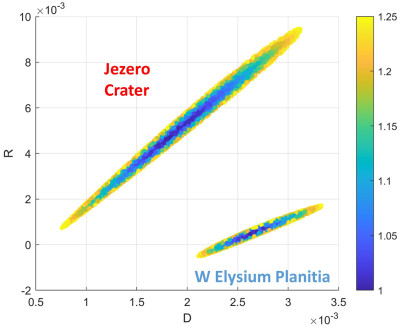The insane mountain slopes of Mars’ deep canyons

Cool image time! The picture to the right, rotated, cropped, reduced, and sharpened to post here, was taken on April 25, 2024 by the high resolution camera on Mars Reconnaissance Orbiter (MRO).
The scientists label this layered deposits, but that hardly describes what we are looking at. This slope, as shown in the overview map above, is the north flank of the central ridgeline inside the giant enclosed canyon depression dubbed Hebes Chasma, located just north of the main canyon of Valles Marineris, the largest known canyon in the solar system.
From floor to peak the ridge is around 16,000 feet high. Yet, its peak sits more than 6,000 feet below the plateau that surrounds Hebes. In this one picture the drop from high to low is only 5,700 feet, with thousands of feet of cliff unseen below and above.
Yet every single foot of these gigantic cliffs is layered. Based on close-up data obtained by Curiosity on the slopes of Mount Sharp in Gale Crater on the other side of the planet, the layers we can see here only represent the most coarse sedimentary boundaries. Within these layers are likely thousands upon thousands of thin additional layers, each likely representing some cyclical climate proces on Mars, even down to individual years.
Note too that the lower slopes in this picture (near the top) suggest some form of erosion flowing downhill. What caused that erosion process however remains unknown. It could have been liquid water, or glaciers, or some other process unique to Mars that we still haven’t uncovered.

Cool image time! The picture to the right, rotated, cropped, reduced, and sharpened to post here, was taken on April 25, 2024 by the high resolution camera on Mars Reconnaissance Orbiter (MRO).
The scientists label this layered deposits, but that hardly describes what we are looking at. This slope, as shown in the overview map above, is the north flank of the central ridgeline inside the giant enclosed canyon depression dubbed Hebes Chasma, located just north of the main canyon of Valles Marineris, the largest known canyon in the solar system.
From floor to peak the ridge is around 16,000 feet high. Yet, its peak sits more than 6,000 feet below the plateau that surrounds Hebes. In this one picture the drop from high to low is only 5,700 feet, with thousands of feet of cliff unseen below and above.
Yet every single foot of these gigantic cliffs is layered. Based on close-up data obtained by Curiosity on the slopes of Mount Sharp in Gale Crater on the other side of the planet, the layers we can see here only represent the most coarse sedimentary boundaries. Within these layers are likely thousands upon thousands of thin additional layers, each likely representing some cyclical climate proces on Mars, even down to individual years.
Note too that the lower slopes in this picture (near the top) suggest some form of erosion flowing downhill. What caused that erosion process however remains unknown. It could have been liquid water, or glaciers, or some other process unique to Mars that we still haven’t uncovered.












